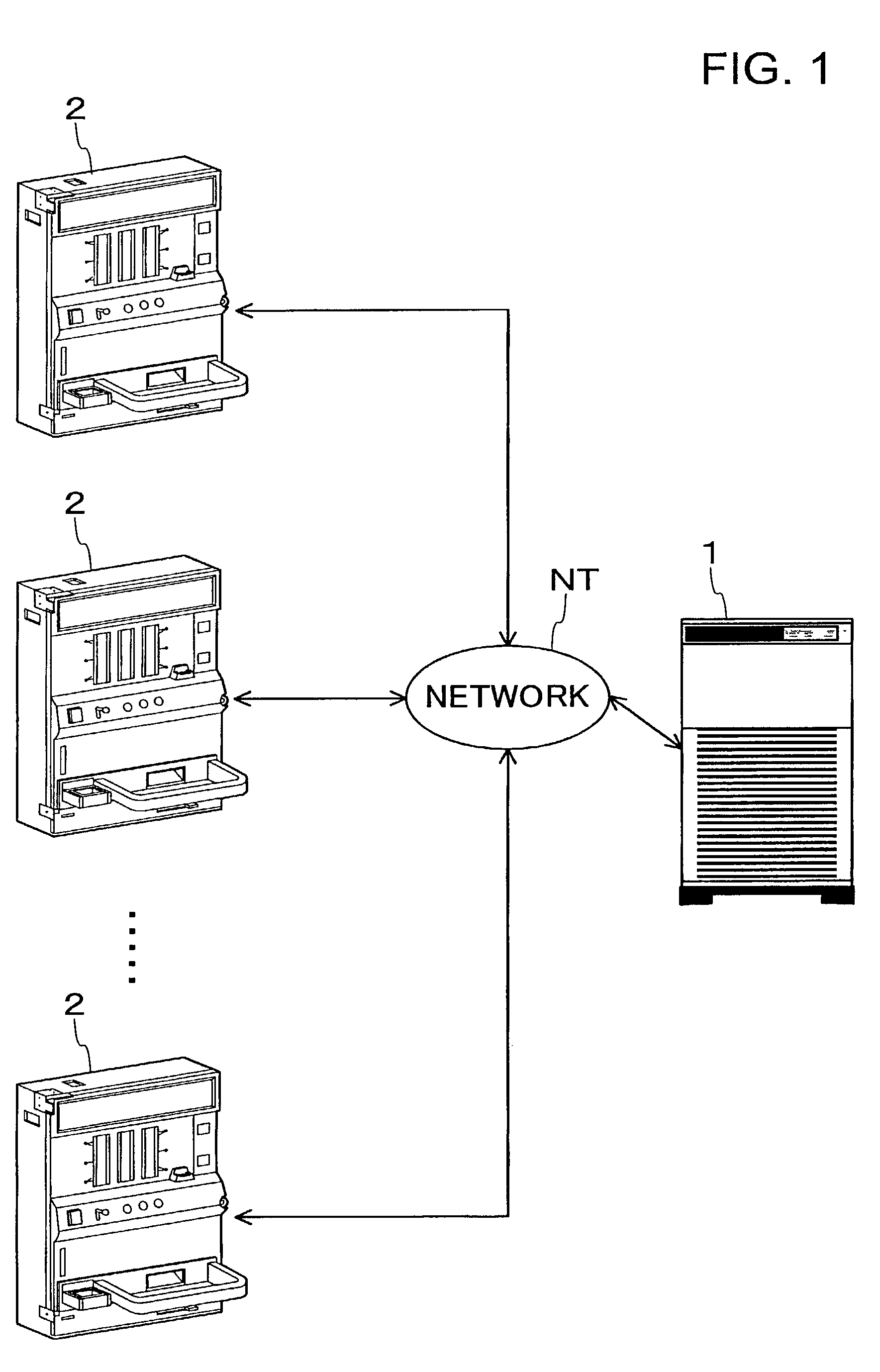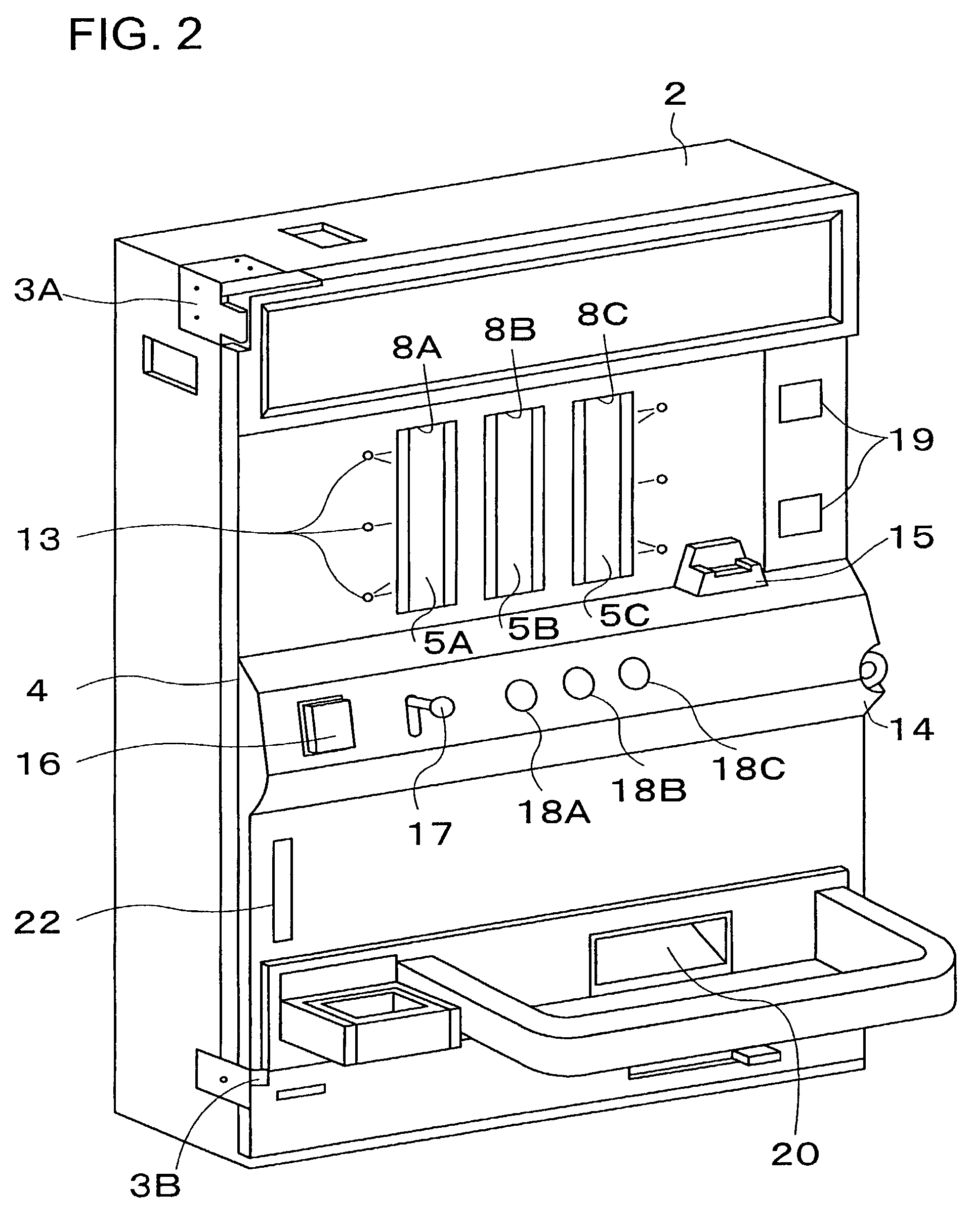[0014]According to the present invention, an object is to achieve the above-described technical task by enabling a player to play a game without anxiety while maintaining amusement of the game, thereby avoiding losing customers.
[0015]In accordance with the present invention, the above object can be achieved by producing higher game characteristics in the following manners comprising: (i) managing per player a cumulative credit consumption of each game machine placed in a parlor, (ii) performing payout return to a player when the cumulative credit consumption of the player reaches an upper limit; and (iii) altering the value of the upper limit properly.
[0017]With the above-described constitution, the upper limit setting that is a key for the payout return of the game machine may be changed. The player is therefore anxious about the upper limit setting, thereby improving game characteristics. Specifically, when the upper limit as the key of the payout return is set high, it is difficult to reach such upper limit so that player changes may frequently occur with the same game machine. Therefore, it is possible that only one player of the plural players, who have played games with the same game machine, may be benefited since he plays a game when the upper limit is reached. Under this circumstance, the players may have to use their own tactics for benefiting themselves, thereby producing high game characteristics. On the other hand, when the upper limit of the key to the payout return is set low, the players may perform a game without anxiety. In an alternative, the payout return may not always be executed to the player who reaches the predetermined upper limit. In this instance, the task to maintain customers without losing them due to an excessive elimination of gambling characteristics may be achieved by producing higher game characteristics and higher gambling characteristics. In another alternative, the payout return may be controlled such that it is executed based on the result of the lottery for determining whether the payout return should be done. In still another alternative to be described later, without performing any lottery to determine whether the payout return should be done, the payout return may be executed with every game machine reaching the upper limit as a so-called default payout return standard. With the above-described constitution, such a new effect as described below is expectable.
[0021]With the above-described constitution, whether the predetermined upper limit is reached is determined per player as opposed to per game machine. Specifically, under the condition that one player who has started a game with one game machine continues the game without stopping the game until the predetermined upper limit with the one game machine is reached, the payout return is executed to the one player. This ensures a certain return to the player. If the case that one player changes game machines many times is compared to the case that one player sticks to the same game machine to continue the game, the latter has higher probability of the payout return since the cumulative credit consumption of the one player tends to reach the predetermined upper limit. Hence, the player, who knows the payout return system, is more likely to continue the game with the same game machine. As the result, it is more possible to keep customers continuing the game than the case of performing the payout return per game machine.
[0023]With the above-described constitution, when one player who has started a game with one game machine stops the game before reaching a predetermined upper limit so that the one player is replaced with another player, the cumulative credit consumption of the one player (the previous player) is reset. Thereby, like the effect described in the above (3), the payout return is assured to the player who has spent game mediums or credit numbers, not to the game machine. As the result, the player can continue the game with the currently playing game machine without anxiety. It is also capable of inducing the player to continue the game until the payout return is executed. In addition, it is possible to minimize such imbalance between players who has quit playing and started the game with the same one game machine. That is, just after one player who has played a game with one game machine without reaching the predetermined upper limit moves to another game machine, another player (the following next player) takes the same game machine (one game machine) and plays his game to reach the upper limit so that the payout return is executed to the new player (another player). Consequently, there is the chance of recover customers who have been away from the game machine that performs return per game machine but involves the above-mentioned imbalance between players.
[0027]With this constitution, after reaching the upper limit, the upper limit is changed to a new value for the next run. That is, the upper limit remains unchanged till the upper limit is reached. Hence the player who has reached the upper limit tends to pay his / her attention to the new upper limit (next upper limit). As the result, the game characteristics can be improved. Especially in a game machine characterized in that the payout return is not always executed upon attainment of a predetermined upper limit, the player checks the next upper limit (optionally with incidental conditions) so that he / she (“he” hereafter) may use what he checked as material for deciding whether he should continue. For example, when the next upper limit is set low, even if the payout return is not yet executed, the player may continue the game without anxiety. On the other hand, when the next upper limit is set high, the game characteristics can be improved by making the player waver in his judgment as to whether he should continue the game.
 Login to View More
Login to View More  Login to View More
Login to View More 


